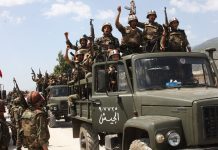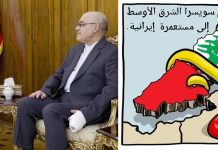
The Internal Collapse Facing Lebanon’s Shiites/حلا نصر الله: المجتمع الشيعي اللبناني ومظاهر الانهيار الداخلي
Hala Nasrallah/Washington Institute for Near East Policy.
March 6, 2017
There is no hiding the religious zeal that gripped Lebanon’s Shiites when, in 2013, Hezbollah chief Hassan Nasrallah launched the group’s campaign to defend the Syrian regime of Bashar Al-Assad. Thousands of fighters, imbued with the illusion of rapid victories, crossed the Lebanese border into Syria believing that they would deliver the enemy a resounding defeat. But as the years passed, their ambitions have turned into bitter experiences with violence. Many have died in the war, and years of fighting have smashed tangled illusions of life, death, and self-sacrifice.
The Shiite media apparatus has pushed thousands of people to see the Syrian conflict as a holy war, stirring up conspiracy theories and fear of the Other. Since the start of the conflict, there have been hysterical references to the massacre of Hussein and the oppression of Shiites throughout history, creating a religious fervor and a desire for revenge. But that idea quickly turned to shock. Amid the hysteria of war, Shiites’ feeling of power and an ability to do as they pleased swept away any sense of danger. That rapidly led to intercommunity conflict, guaranteeing the familiar way of life in Shiite areas would be destroyed.
Propaganda outlets have typically portrayed Shiites as a group in harmony with itself, but such media reports of a coherent community are now false. Now many Lebanese Shiites are living through one of the toughest periods in their history. Their social fabric has fallen apart and the class gap between them has widened massively. The country’s impoverished Shiite districts have closed in on themselves, and youth unemployment has skyrocketed.
Not all Shiites in Lebanon belong to the two main parties, Hezbollah or Amal. While there are few statistics or opinion polls on Lebanese party affiliations, the latest municipal elections in April and May 2016 exposed the massive rift between Shiite communities and their political representatives.
For example, in southern Lebanon, the Bekaa valley and Beirut’s southern Dahiyeh district ran their own electoral lists, which rivaled those of the two major Shiite parties.
Hezbollah and Amal felt the strength of the negative signals coming from these rivals, prompting them to join forces in many local elections. Setting up joint lists, they tried to hide their mutual dislike as much as possible — an awkward feat for both.
In Baalbek, near the Syrian border, which Hezbollah describes as the land of the martyrs, the party took a painful hit as some 40 percent of the vote went to the “Baalbek is my City” list headed by political activist and Hezbollah critic Ghaleb Yaghi.
The city’s residents have long complained of security concerns, which have grown in recent years. Many have condemned the poor security situation, the absence of the state, the lack of development projects and the pervasive militia mentality.
Today, Hezbollah is working with the official Lebanese security apparatus to attempt a resolution to problems posed by thousands of these lawbreakers.For example, local media reported that a Hezbollah delegation met with Lebanon’s Justice Minister Salim Jreissati to examine the crisis around those accused of various crimes. Sources in Beirut said that most of the criminals who may be granted amnesty were Shiites. On February 2, Hezbollah MP Ali Al-Miqdad told the Al-Modon website that coordination was underway with the security services to find a legal solution for 37,000 arrests.
The poor, the unemployed, drug addicts, gangs, criminals, and those harmed by the shrinking of the middle class and the concentration of wealth in the hands of two parties form a constituency fraught with violence. The Shiite leadership is unable to work out how it will reform itself and avoid the risk of implosion.
In August 2016, Nasrallah tried to blame the chaos in Lebanon’s Shiite communities on the extension of the Lebanese map by local actors, evading his responsibilities towards the tough, complex situation in which his community found itself.Instead, in a meeting with locals in Baalbek, he urged them to give up those on the wanted list to the authorities. The Bekaa Shiites are not alone in taking the path of unpredictable chaos. The residents of Beirut’s southern Dahiyeh district are also bracing for the future after hundreds of gangs infiltrated the area.
Gangs have taken root in various parts of Lebanon, working to provide the basic needs of the population. But in Shiite areas, gangs pose a major threat to local peace and security.
Gangs with black market experience are working to impose their authority in parallel to that of the state and the parties. The lack of development and the state’s inability to provide essential services such as water and electricity have allowed for the rise of gangs that can provide such services, albeit at great expense.
Dahiyeh is the biggest district of Beirut and the vast majority of its residents are Shiites. In 2016, the area witnessed 11 murders, most of them linked to revenge and drug trafficking. In recent years, the district has seen repeated attempts at bank robberies, gunfire and even the firing of mortar rounds during party celebrations and events such as the funerals of Hezbollah fighters.
On February 8, Al-Jadid channel reported that a gang was running a protection racket in the district. It showed them setting fire to electricity generators, causing a fire in a residential building, and described the gang’s actions as “terrorism”. The report included an appeal by locals for “security forces to take a decisive decision and end the state of lawlessness and destroy the gangs.”
Just days later, unknown arsonists set fire to electricity generators in another part of Dahiyeh. Officials were quick to cover up the event.
On February 14, a video by a group of young Shiites in the southern city of Tyre was leaked showing dozens of people beating up the police commissioner at the municipality of the city, Shadi Najdi. The crowd was reportedly resentful at Najdi for ordering raids in several parts of the city.
Such events are unfamiliar and hard to accept, but they take root in the structure of society wherever they find an opportunity. Hezbollah has reined in the gangs to a certain degree by forcing them to sign agreements not to enter into battles with other gangs.
But it is difficult to separate the gangs from the ruling authorities because they have entered into so many secret agreements and set up a single body to protect their shared interests. Furthermore, the string of crimes by gangs and the growing frustration of the public, who call on the parties to live up to their responsibilities to hand in criminals and the people undermining security, shows that there has been a dangerous flip in the equation. The dominant forces, whether parties or mafias, are edging ever closer to battle with each other.
On top of harsh political and religious discourse full of militarism and populism accompanying the Syrian conflict, there are parts of society that have already been marginalized for many years. This has played a major role in nurturing and directing community violence. Shiite authorities have made use of it, through studied and precisely targeted methods, to dominate how people think and behave.
As Shiites have been marginalized within their communities, their concerns and run-down districts forgotten, some of them have become de facto authorities, practicing their domination over the weak.
Since Hezbollah was founded, it has kept its political and ideological discourse within clear boundaries, linked to regional and local conflicts. The Amal movement has stuck to playing the game of official politics with other parties in Lebanon’s quota system. Thus, the daily concerns of a huge number of Shiites are largely ignored. Tens of thousands of people have not found a platform for their situation, because they have been reduced to tools for disguising twisted political conduct.
The relationship between the leadership and their constituency has been cracking of late, slowly pulling Shiites into a conflict between themselves. As the years go on, the split between the top and bottom of the pyramid is likely to grow.
It is hard for certain individuals to understand the broader effects of their actions and the way the Shiite community is being thrust towards instability. They represent the first ground for objections, quarrels, and the growing tide of chaos that challenges any authority.
The Lebanese government must pay attention, although they will not be able to fix the situation. Nor will they be able to escape, because when the pyramid collapses, every part of it will fall to the ground. Lebanon’s Shiites are not expecting a happy conclusion — only a stage of even greater chaos.
Fikra Forum is an initiative of the Washington Institute for Near East Policy. The views expressed by Fikra Forum contributors are the personal views of the individual authors, and are not necessarily endorsed by the Institute, its staff, Board of Directors, or Board of Advisors.
المجتمع الشيعي اللبناني ومظاهر الانهيار الداخلي
حلا نصر الله/معهد واشنطن لسياسة الشرق الأدنى
لا يخفى على أحد كمية الحماسة الدينية التي رافقت شيعة لبنان عندما أطلق أمين عام حزب الله حسن نصر الله عام 2013 رحلة المضي إلى معركة الدفاع عن نظام الرئيس السوري بشار الأسد. آلاف المقاتلين معبؤون بأوهام الانتصارات السريعة عبروا الحدود اللبنانية نحو الأراضي السورية، ظناً منهم أنهم سيلحقون بالعدو أعتى أنواع الهزائم، إلا أن مرور السنوات حَوّل طموحهم إلى واقع تتزاحم فيه النتائج السوداء للحرب. نزعت الحرب أرواح آلاف الشبان الشيعة. كانت سنوات المشاركة في الصراع كافية لكسر أوهام مركبة عن الحياة والموت والتضحية بالنفس. لعبت الآلة الإعلامية الشيعية دوراً في دفع آلاف الجماهير لمنح الحرب السورية سمات القداسة بالاستناد إلى رهبة الخوف من الآخر. ومنذ اشتعال الحرب في سوريا هيمنت فكرة الملحمة الحسينية ومظلومية الشيعة عبر التاريخ وتم الترويج لها بأسلوب هستيري، مما خلق حالة غليان ديني والحاجة إلى الثأر. ولكن الفكرة نفسها ما لبث أن تفككت وتحولت إلى صدمة. وتحت وطأة هستيريا الحرب اجتاح شعور فائض القوة وحرية التصرف للنيّل من أي خطر ولم يتوانى هذا الشعور ولو للحظة عن إنتاج سلوكيات جماعية باتت كفيلة كي تدمر الصيغة المعهودة لحياة الشيعة في مناطقهم.
وقد سعت الدعاية الإعلامية لهيكلة المجتمع الشيعي على أنه كيان متآلفة مع نفسه، إلا أن الأكاذيب المروّج لها إعلاميا عن تركيبة المجتمع المتماسك ليست صحيحة. يعيش جزء من شيعة لبنان أتعس مراحلهم لما يشهدوه من انقلاب يلامس منظومتهم الأخلاقية من جهة، وتوسعت من جهة أخرى الفروقات الطبقية فيما بينهم بشكل ملحوظ وانكمشت أحزمة البؤس الشيعية على نفسها، وتضخمت نسبة الشبان العاطلين عن العمل.
ليس كل شيعة لبنان، ينتمون إلى الحزبيين الرئيسين حزب الله وحركة أمل. وعلى الرغم من غياب الإحصاءات واستطلاعات الرأي المخصصة لدراسة ميول المواطنين اللبنانيين الحزبية، إلا أن جولة انتخابات البلديات التي جرت بين شهريّ نيسان وأيار من عام 2016 أثبتت حجم الهوة والضحالة بين تطلعات المجتمع الشيعي من جهة وبين ممثليهم السياسيين من جهة أخرى. وعلى سبيل المثال، شكلت العائلات والعشائر في جنوب لبنان والبقاع وضاحية بيروت الجنوبية لوائح انتخابية تنافس الحزبين الشيعيين الرئيسين.
ومن المؤكد أن حزب الله وحركة أمل شعرا بثقل الإشارات السلبية القادمة من المنافسة الشرسة، مما دفعهما إلى تشكيل لوائح مشتركة في العديد من الانتخابات المحلية. وبقدر المستطاع، حاول الحزبان إخفاء الكراهية الموجودة بينهما.
ففي مدينة بعلبك المجاورة للحدود السورية، والتي يصفها إعلام حزب الله بأنها ارض الشهداء، تلقى الأخير ضربة مؤلمة بعد تصويت 40% من الناخبين للائحة “بعلبك مدينتي” التي ترأسها الناشط السياسي والخصم اللدود غالب ياغي.
ودائماً ما يشتكي أبناء بعلبك من المظاهر المخلة بالأمن التي تعاظمت في السنوات الأخيرة، وكثيراً ما ارتفعت الأصوات المنددة بالفلتان الأمني وغياب الدولة وانعدام المشاريع الإنمائية وسيادة العقلية الميليشياوية.
وحالياً يسعى حزب الله بالتعاون مع القوى الأمنية الرسمية في لبنان إلى حل مشكلة آلاف الأشخاص الخارجين عن القانون. فمثلاً، أكدت الوسائل الإعلامية اللبنانية حصول لقاء جمع وفد من حزب الله مع وزير العدل اللبناني سليم جريصاتي بهدف البحث في أزمة المتهمين بارتكاب جرائم متنوعة. وأشارت المصادر في بيروت إلى أن أغلب الخارجين عن القانون المطالب بالعفو عنهم ينتمون إلى الطائفة الشيعية. وبتاريخ 2 شباط 2017 أكد النائب عن كتلة حزب الله في البرلمان اللبناني علي المقداد لموقع “المدن” اللبناني بأن التعاون جارٍ مع الأجهزة الأمنية الرسمية لإيجاد مخرج قانوني لهؤلاء المطلوبين من قبل الجهات الأمنية والذين يبلغ عددهم 37 ألف.
إن الفقراء والعاطلون عن العمل والخارجون عن القانون والمجرمون ومدمنو المخدرات والعصابات على مختلف أنواعها والمتضرِّرون من انحسار الطبقة الوسطى وتمركز رؤوس الأموال بيد الحزبين، يشكلون حقل عنف مشحون تعجز الزعامة الشيعية لإصلاح نفسها وذلك لتجنب حدوث انهيار.
ففي شهر آب من عام 2016 حاول نصر الله إلقاء تبيعات الفوضى الحاصلة في التجمعات الشيعية على امتداد الخريطة اللبنانية فوق أكتاف الفاعلين المحليين، وذلك حين تملص من مسؤوليته تجاه ما وصلت إليه الطائفة من واقع مزري ومعقد. وقد طلب نصر الله خلال لقاءه مع أبناء بعلبك أن يعملوا بكثافة على تسليم المطلوبين بمذكرات بحث وتحرٍ إلى الأجهزة الأمنية. ليس شيعة بعلبك وحدهم من يسلكون طريق فوضى من الصعب توقُع أو تنبؤ ما تخفيه، فسكان ضاحية بيروت الجنوبية هم أيضا يهيئون أنفسهم لتقبل واقعهم الجديد الذي تكلل بنشوء شبكة تضم مئات العصابات والتي استطاعت التغلغل بينهم.
في مختلف المناطق اللبنانية تنتشر العصابات التي تعمل على تأمين المستلزمات الضرورية للسكان. إلا أنها داخل التجمعات الشيعية، تشكل تلك العصابة تهديدا رئيسيا للسلام والأمن المحلي. وتسعى العصابات المتمرسة في ميادين التجارة غير القانونية إلى فرض هيبتها بأسلوب يوازي سلطة الأجهزة الرسمية والحزبية، وأدى غياب المشاريع الإنمائية للدولة اللبنانية وعجزها عن توفير خدمات ضرورية للمواطنين كالمياه والكهرباء وغيرها، إلى نشوء عصابات توفر للسكان مجموع خدمات مقابل مبالغ مالية باهظة.
إن الضاحية الجنوبية تمثل أكبر تجمع سكاني ضمن نطاق العاصمة بيروت والذي ينتمي بغالبيته العظمى إلى الشيعة. في عام 2016 شهدت الضاحية 11 جريمة قتل وقد احتوت النسبة الأكبر من تلك الأحداث على علاقة مبطنة مع الثأر وتهريب المخدرات. وفي الأعوام المنصرمة شهدت الضاحية أيضا اعتداءات متكررة على البنوك بهدف سرقتها، بالإضافة إلى إطلاق الأعيرة النارية والقذائف الحربية بشكل عشوائي وذلك خلال الاحتفالات والمناسبات الحزبية وأثناء تشييع المقاتلين.
وفي 8 شباط 2017، عرضت قناة “الجديد” اللبنانية تقريراً مصوراً، أظهرت فيه قيام أحد العصابات التي تفرض الخوة على المحال التجارية في الضاحية بإحراق مولدات كهربائية مما أدى إلى اشتعال مبنى سكني. ووصفت “الجديد” تصرف العصابة بالإرهابي، وتناول التقرير مناشدة أبناء الضاحية «القوى الأمنية لاتخاذ قرار حاسم وإنهاء حالة التمرد على القانون والقضاء على العصابات».
ولم تمضي أيام على تلك الحادثة، حتى أقدمت مافيا مجهولة على إحراق مولدات كهربائية في منطقة أخرى في ضاحية بيروت الجنوبية فسارع المسؤولون إلى الالتفاف على الحدث والتكتم عليه.
كما وسُربَ في 14 شباط 2017 فيديو لمجموعة شبان شيعة من مدينة صور في جنوب لبنان، يوثق الفيديو لحظة قيام عشرات الأشخاص بضرب قائد شرطة بلدية صور شادي نجدي، وكشفت التقارير أن الشبان ممتعضون من نجدي لأنه خطط وأشرف على عملية مداهمة عدة أحياء في المدينة.
إن تلك الظواهر بمثابة كيان غريب يَصعُب التأقلم معه، لأنه يتحرك خارج المألوف، ويتجذر عميقاً في البنية كلما سنحت له الفرصة. حتى أن حزب الله يُخضع جموح العصابات عبر إجبارها على توقيع اتفاقيات شكلية يضمن من خلالها ألا تقوم عصابة بممارسة العنف ضد عصابة أخرى.
ولكن من الصعب فصل العصابات عن السلطة الحاكمة لأنهم بنوا فيما بينهم تفاهمات سرية، وشكلوا جسما واحدا يؤمن المصالح المشتركة. إلا أن سلسلة الجرائم المرتكبة من قبل العصابات وتفاقم انزعاج الناس الذين يُطالبون الأحزاب بتحمل مسؤولياتهم برفع الغطاء عن مفتعلي الشغب والمخلين بالأمن يُثبت حصول انقلاب خطير في المعادلة عبر انجرار القوى المسيطرة أكانت الحزبية أم المافياوية للفتك ببعضها البعض.
إن إلى جانب قسوة الخطابات السياسية والدينية المملؤة بروح العسكرة والشعبوية والتي تم الترويج لها لمواكبة الحدث السوري، فقد احتل التهميش وعزل فئات اجتماعية لسنوات مديدة دوراً مهماً لإنتاج العنف ومضاعفته والتحكم به، عبر لجوء السلطة الشيعية إلى استثمارها وفق آليات مدروسة ودقيقة الأهداف للسيطرة على نماذج الناس الفكرية والسلوكية.
إن إقصاء جزء كبير من الشيعة داخل مجتمعاتهم ونسيان أوجاعهم وهموم مناطقهم المتهالكة، حوّل بعضهم إلى سلطة تمارس الفوقية والتسلط على من هم أضعف منهم.
منذ لحظة نشؤه، رسم حزب الله حدود متينة لخطابه السياسي والأيديولوجي، وربطه بالصراعات الإقليمية والمحلية. بينما حركة أمل ضبطت نفسها في لعبة السلطة الرسمية والمحاصصة السياسية مع بقية الأحزاب، لذلك بقيت الشؤون الحياتية لشرائح ضخمة من المجتمع الشيعي خارج الخطابات الحماسية. وإلى يومنا هذا لم يجد عشرات الآلاف من الأشخاص أي مساحة يُعبرون فيها عن وجودهم ذلك أنهم كانوا احدى أدوات تمويه السلوك السياسي المهترئ. ومؤخراً بدأ تصدع العلاقة بين الزعامة والحاشية يجر الشيعة ولو ببطء نحو مواجهة فيما بينهم ومع السنوات سيزداد الشرخ بين رأس الهرم وقعره.
من الصعب على الأفراد فهم خلفية تصرفاتها وأفعالهم واندفاعهم نحو تحقيق اللا استقرار داخل البيئة الشيعية. فهم يمثلون الأرضية الأولى للاعتراض والمشاكسة واستسهال الفوضى بوجه أي سلطة. يجب على الدولة اللبنانية أن تولى اهتماما أكبر بالمواطنين بعد أن عجزت الأحزاب الشيعية عن ضبط الأوضاع أو إصلاحها، فهي لن تتمكن من الهروب بعيدا لأن الهرم عندما يتفكك، يسقط بكامل مكوناته على الأرض. وأخيرا، لا يتوقع شيعة لبنان تحقيق نهاية سعيدة بل مزيدا من الفوضى.
Fikra Forum is an initiative of the Washington Institute for Near East Policy. The views expressed by Fikra Forum contributors are the personal views of the individual authors, and are not necessarily endorsed by the Institute, its staff, Board of Directors, or Board of Advisors.
منتدى فكرة هو مبادرة لمعهد واشنطن لسياسة الشرق الأدنى. والآراء إلى يطرحها مساهمي المنتدى لا يقرها المعهد بالضرورة، ولا موظفيه ولا مجلس أدارته، ولا مجلس مستشاريه، وإنما تعبر فقط عن رأى صاحبها.






















